Compositional Characterization and Chronology of Roman Mortars from the Archaeological Site of Arroyo De La Dehesa De Velasco (Burgo De Osma- Ciudad De Osma, Soria, Spain)
Abstract
1. Introduction
2. Materials and Methods
2.1. Materials
2.2. Methods
3. Results and Discussion
4. Conclusions
Author Contributions
Funding
Acknowledgments
Conflicts of Interest
References
- Furlan, V.; Bissegger, P. Les mortiers anciens, Historie et essais d’analyse scientifique. Rev. Suiss. D’art Archaéol 1975, 32, 2–14. [Google Scholar]
- Cowan, H.J. The Master Builders: A History of Structural and Environmental Design from Ancient Egypt to the Nineteenth Century; John Willey & Sons: New York, NY, USA, 1977; pp. 1–299. [Google Scholar]
- Malinowski, R. Ancient mortars and concretes: Aspects of their durability. In History of Technology; Hall, A.R., Smith, N., Eds.; Mansell: London, UK, 1982; 7th annual Volume, pp. 89–101. [Google Scholar]
- Von Landsberg, D. The history of lime production and use from early times to the industrial revolution. Zem. Kalk-Gips 1992, 45, 199–203. [Google Scholar]
- Hughes, J.J.; Válek, J. Mortars in Historic Buildings: A Review of the Conservation, Technical and Scientific Literature; Historic: Edinburgh, Scotland, 2003; pp. 1–88. [Google Scholar]
- Moropoulou, A.; Bakolas, A.; Anagnostopoulou, S. Composite materials in ancient structures. Cem. Concr. Comp. 2005, 27, 295–300. [Google Scholar] [CrossRef]
- Válek, J.; Hughes, J.J.; Groot, J.W.P. Historic Mortars: Characterization, Assessment and Repair; RILEM Bookseries; Springer: New York, NY, USA, 2012. [Google Scholar]
- Artioli, G.; Secco, M.; Addis, A. The Vitruvian legacy: Mortar and binders before and after the Roma world. In The Contribution of Mineralogy to Cultural Heritage; Artioli, G., Oberti, R., Eds.; The Mineralogical Society: Middlesex, UK, 2019; Volume 20, pp. 151–202. [Google Scholar] [CrossRef]
- Ortega, L.A.; Zuluaga, M.C.; Alonso Olazabal, A.; Insausti, M.; Ibáñez, A. Geochemical characterization of archaeological lime mortars: Provenance inputs. Archeometry 2008, 50, 387–408. [Google Scholar] [CrossRef]
- Sanjurgo-Sánchez, J.; Trindade, M.J.; Blanco-Rotea, R.; Benavides García, R.; Fernández Mosquera, D.; Burbidge, C.; Prudencio, M.I.; Dias, M.I. Chemical characterization of historic mortars from the Santa Eulalia de Bóveda temple, NW Spain. J. Archaeol. Sci. 2010, 37, 2346–2351. [Google Scholar] [CrossRef]
- Santos Silva, A.; Adriano, P.; Magalhaes, A.; Pires, J.; Carvalho, A.; Cruz, A.J. Characterization of historical mortars from Alentejo’s religious buildings. Int. J. Archit. Herit. 2010, 4, 138–154. [Google Scholar] [CrossRef]
- Miriello, D.; Barca, D.; Pecci, A.; De Luca, R.; Crisci, G.M.; López Luján, L.; Barba, L. Plasters from different buildings of the Sacred Precinct of Tenochtitlan (Mexico City): Characterization and provenance. Archaeometry 2015, 57, 100–127. [Google Scholar] [CrossRef]
- Moropoulou, A.; Bakolas, A.; Bisbikou, K. Investigation of the technology of historic mortars. J. Cult. Herit. 2000, 1, 45–58. [Google Scholar] [CrossRef]
- Kirca, Ö. Ancient binding materials, mortars and concrete technology: History and durability aspects. In Structural Analysis of Historical Constructions; Modena, C., Lourenço, P.B., Roca, P., Eds.; Taylor & Francis Group: London, UK, 2005; pp. 87–95. [Google Scholar]
- Pavia, S.; Caro, S. An investigation of Roman mortar technology through the petrographic analysis of archaeological material. Constr. Build. Mater. 2008, 22, 1807–1811. [Google Scholar] [CrossRef]
- Miriello, D.; Barca, D.; Crisci, G.M.; Barba, L.; Blancas, J.; Ortiz, A.; Pecci, A.; Lopez Luján, L. Characterization and provenance of lime plasters from the Templo Mayor of Tenochtitlan (Mexico City). Archaeometry 2011, 53, 1119–1141. [Google Scholar] [CrossRef]
- Tenconi, M.; Karatasios, I.; Bala’awi, F.; Kilikoglou, V. Technological and microstructural characterization of mortars and plasters from the Roman site of Qasr Azraq, in Jordan. J. Cult. Herit. 2018, 33, 100–116. [Google Scholar] [CrossRef]
- Miriello, D.; Barca, D.; Bloise, A.; Ciarallo, A.; Crisci, G.M.; De Rose, T.; Gattuso, C.; Gazineo, F.; La Russa, M.F. Characterisation of archaeological mortars from Pompeii (Campania, Italy) and identification of construction phases by compositional data analysis. J. Archaeol. Sci. 2010, 37, 2207–2223. [Google Scholar] [CrossRef]
- Kramar, S.; Zalar, V.; Urosevic, M.; Körner, W.; Mauko, A.; Mirtič, B.; Lux, J.; Mladenović, A. Mineralogical and microstructural studies of mortars from the bath complex of the Roman villa rustica near Mošnje (Slovenia). Mater. Charact. 2011, 62, 1042–1057. [Google Scholar] [CrossRef]
- Pecci, A.; Miriello, D.; Barca, D.; Crisci, G.M.; De Luca, R.; Ortiz, A.; Manzanilla, L.R.; Blancas, J.; Barba, L. Identifying a technological style in the making of lime plasters at Teopancazco (Teotihuacan, México). Archaeol. Anthropol. Sci. 2018, 10, 315–335. [Google Scholar] [CrossRef]
- Miriello, D.; Bloise, A.; Crisci, G.M.; De Luca, R.; De Nigris, B.; Martellone, A.; Osanna, M.; Pace, R.; Pecci, A.; Ruggieri, N. New compositional data on ancient mortars and plasters from Pompeii (Campania–Southern Italy): Archaeometric results and considerations about their time evolution. Mater. Charact. 2018, 146, 189–203. [Google Scholar] [CrossRef]
- Hale, J.; Heinemeier, J.; Lancaster, L.; Lindroos, A.; Ringbom, A. Dating Ancient Mortar. Am. Sci. 2003, 91, 130–137. [Google Scholar] [CrossRef]
- Heinemeier, J.; Jungner, H.; Lindroos, A.; Ringbom, A.; von Konow, T.; Rud, N. AMS 14C dating of lime mortar. Nucl. Instrum. Methods Phys. Res. Sect. B Beam Interact. Mater. At. 1997, 123, 487–495. [Google Scholar] [CrossRef]
- Lindroos, A.; Heinemeier, J.; Ringbom, Å.; Braskén, M.; Sveinbjörnsdóttir, Á. Mortar dating using AMS 14C and sequential dissolution: Examples from medieval, non-hydraulic lime mortars from the Åland Islands, SW Finland. Radiocarbon 2007, 49, 47–67. [Google Scholar] [CrossRef]
- Nawrocka, D.M.; Michczynska, D.J.; Pazdur, A.; Czernik, J. Application of radiocarbon method for dating of lime mortars. Geochronometria 2005, 24, 109–115. [Google Scholar]
- Ringbom, Å.; Lindroos, A.; Heinemeier, J.; Sonck-Koota, P. 19 years of mortar dating: Learning from experience. Radiocarbon 2014, 56, 619–635. [Google Scholar] [CrossRef]
- Marzaioli, F.; Nonni, S.; Passariello, I.; Capano, M.; Riccio, P.; Lubritto, C.; De Cesare, N.; Eramo, G.; Quiros Castillos, J.A.; Terrasi, F. Accelerator mass spectrometry 14C dating of lime mortars. Methodological aspects and field study application at CIRCE (Italy). Nucl. Instrum. Methods Phys. Res. Sect. B Beam Interact. Mater. At. 2013, 294, 246–251. [Google Scholar] [CrossRef]
- Hajdas, I.; Lindroos, A.; Heinemeier, J.; Ringbom, Å.; Marzaioli, F.; Terrasi, F.; Passariello, I.; Capano, M.; Artioli, G.; Addis, A.; et al. Preparation and dating of mortar samples-mortar dating inter-comparison study (MODIS). Radiocarbon 2017, 59, 1845–1858. [Google Scholar] [CrossRef]
- Peroni, S.; Tersigni, C.; Torraca, G.; Cerea, S.; Forti, M.; Guidobaldi, F.; Rossi-Doria, P.; De Rege, A.; Picchi, D.; Pietrafitta, F.J.; et al. Lime based mortars for the repair ancient masonry and possible substitutes. In Mortars, Cements, and Grouts Used in the Conservation of Historic Buildings-Mortiers, Ciments et Coulis Utilizes Dans la Conservationdes Batiments Historiques; Symposium ICCROM: Rome, Italy, 1981; pp. 63–100. [Google Scholar]
- Groot, C.J.W.P.; Bartos, P.J.M.; Hughes, J.J. Historic mortars: Characteristics and test- concluding summary and state-of-the-art. In Historic Mortars: Characteristics and Tests; Bartos, P., Groot, C., Hughes, J.J., Eds.; RILEM Publications: Cachan Cedex, France, 2000; pp. 443–454. [Google Scholar]
- Elert, K.; Rodríguez-Navarro, C.; Sebastián Pardo, E.; Hansen, E.; Cazalla, O. Lime mortars for the conservation of historic buildings. Stud. Conserv. 2002, 47, 62–75. [Google Scholar]
- Rodríguez-Navarro, C. Binder in historical building: Traditional lime in conservation. In International Seminar on Archaeometry and Cultural Heritage: The Contribution of Mineralogy; Herrero, J.M., Vendrell, M., Eds.; Soc España de Miner Seminars: Madrid, Spain, 2012; pp. 91–112. [Google Scholar]
- Torney, C.; Forster, A.; Szadurski, E.M. Restoration mortars in conservation work: Considerations & compatibility. In Proceedings of the 3rd Historic Mortars Conference, Glasgow, Scotland, 11–14 September 2013. [Google Scholar]
- Pacheco-Torgal, F.; Labrincha, J.A.; Leonelli, C.; Palomo, A.; Chindaprasirt, P. Handbook of Alkali-Activated Cements, Mortars and Concretes, 1st ed.; Woodhead Publishing, Elsevier: Amsterdam, The Netherlands, 2014; p. 852. [Google Scholar]
- Kurtis, K.E. Innovations in cement-based materials: Addressing sustainability in structural and infrastructure applications. Mat. Res. Soc. Bull. 2015, 40, 1102–1109. [Google Scholar] [CrossRef]
- Liew, K.M.; Sojobi, A.O.; Zhang, L.W. Green concrete: Prospects and challenges. Constr. Build. Mater. 2017, 156, 1063–1095. [Google Scholar] [CrossRef]
- Du, S.; Wu, J.; Alshareedah, O.; Shi, X. Nanotechnology in cement-based materials: A review of durability, modeling, and advanced characterization. Nanomaterials 2019, 9, 136. [Google Scholar] [CrossRef]
- Da Silva, M.; de Brito, J.; Veiga, R. Incorporation of fine plastic aggregates in rendering mortars. Construct. Build. Mater. 2014, 71, 226–236. [Google Scholar] [CrossRef]
- Fan, M.; Fu, F. Advanced High Strengh Natural Fibre Composites in Construction, 1st ed.; Fan, M., Fu, F., Eds.; Woodhead Publishing, Elsevier: Amsterdam, The Netherlands, 2016; p. 596. [Google Scholar]
- Vitruvius Pollio, M. The Architecture; Priestly and Weale: London, UK, 1826. [Google Scholar]
- Bostock, J.; Riley, H.T. The Natural History of Pliny; Bohm HG: London, UK, 1857. [Google Scholar]
- Ruiz Fernández de la Lopa, V.; Valverde Hernández, M. Memoria Mapa Geológico España 1:50.000 n. 377; IGME: Madrid, Spain, 1991. [Google Scholar]
- García Merino, C. Uxama I (Campañas de 1976 y 1978): Casa de la Cantera, Casa del Sectile y “el Tambor”; Instituto de Conservación y Restauración de Bienes Culturales: Madrid, España, 1995; p. 170. [Google Scholar]
- García Merino, C. Urbanización y Ordenación del Territorio en Uxama Argaela. Mesa Redonda; Emergência e Desevolvimento das Ciudades Romanas no Norte da Peninsula Ibérica: Porto, Portugal, 1999; pp. 191–221. [Google Scholar]
- García Merino, C. Población y Poblamiento en Hispania Romana. El Conventus Cluniensi; Universidad de Valladolid: Valladolid, España, 1975. [Google Scholar]
- García Merino, C. Las raíces históricas de la sede episcopal oxoniense. Aproximación a la etapa tardo-antigua de Uxama. In Proceedings of the Semana de Estudios históricos de la Diócesis de Osma, Soria, Spain, 15–17 September 1997; Universidad Alfonso VIII y Diputación Soria: Soria, Spain, 2000; Volume 1, pp. 179–196. [Google Scholar]
- Dohijo, E. Evolución y transformación urbana de las ciudades del Alto Valle del Duero durante la Antigüedad Tardía. Espac. Urbanos Occidente Mediterráneo 2011, S. VI-VIII, 219–228. [Google Scholar]
- Artioli, G.; Secco, M.; Addis, A.; Bellotto, M. Role of Hydrotalcite-Type Layered Double Hydroxides in Delayed Pozzolanic Reactions and their Bearing on Mortar Dating Cementitious Materials: Composition, Properties, Application; Pöllmann, H., Ed.; De Gruyter: Berlin, Germany, 2017; pp. 147–158. [Google Scholar] [CrossRef]
- Ponce-Antón, G.; Ortega, L.A.; Zuluaga, M.C.; Alonso-Olazabal, A.; Solaun, J.L. Hydrotalcite and hydrocalumite in mortar binders from the medieval castle of Portilla (Álava, north Spain): Accurate mineralogical control to achieve more reliable chronological ages. Minerals 2018, 8, 326. [Google Scholar] [CrossRef]
- Nonni, S.; Marzaioli, F.; Mignardi, S.; Passariello, I.; Capano, M.; Terrasi, F. Radiocarbon dating of mortars with a pozzolana aggregate using the Cryo2SoniC protocol to isolate the binder. Radiocarbon 2018, 60, 617–637. [Google Scholar] [CrossRef]
- Ortega, L.A.; Zuluaga, M.C.; Alonso-Olazabal, A.; Murelaga, X.; Insausti, M.; Ibañez-Etxeberria, A. Historic lime-mortar 14C dating of Santa María la Real (Zarautz, northern Spain): Extraction of suitable grain size for reliable 14C dating. Radiocarbon 2012, 54, 23–36. [Google Scholar] [CrossRef]
- Ramsey, C.B.; Scott, M.; van der Plicht, H. Calibration for archaeological and environmental terrestrial samples in the time range 26-50 ka cal BP. Radiocarbon 2013, 55, 2021–2027. [Google Scholar] [CrossRef]
- Reimer, P.J.; Bard, E.; Bayliss, A.; Beck, J.W.; Blackwell, P.G.; Ramsey, C.B.; Buck, C.E.; Cheng, H.; Edwards, R.L.; Friedrich, M.; et al. IntCal13 and marine13 radiocarbon age calibration curves 0-50,000 years calBP. Radiocarbon 2013, 55, 1869–1887. [Google Scholar] [CrossRef]
- Boynton, R.S. Chemistry and Technology of Lime and Limestone; Wiley &Sons: New York, NY, USA, 1980. [Google Scholar]
- Bakolas, A.; Biscontin, G.; Moropoulou, A.; Zendri, E. Characterization of the lumps in the mortars of historic masonry. Thermochim. Acta 1995, 269, 809–816. [Google Scholar] [CrossRef]
- Hughes, J.J.; Leslie, A.B.; Callebaut, K. The petrography of lime inclusions in historic lime based mortars. Annal. Geolog. Pays Hellen. 2001, 39, 359–364. [Google Scholar]
- Mora, P.; Mora, L.; Philipot, P. Conservation of Wall Painting; Butterworth& Co.: London, UK, 1984. [Google Scholar]
- Piovesan, R.; Curti, C.; Maritan, L.; Mazzoli, C. Petrographic and microstratigraphic analysis of mortar-based building materials form the temple of Venus, Pompeii. In Interpreting Silent Artefacts: Petrographic Approaches to Archaeological Ceramics; Quinn, P.S., Ed.; Archaeopress: Oxford, UK, 2009; pp. 65–79. [Google Scholar]
- Pachta, V.; Stefanidou, M. Technology of multilayer mortars applied in ancient floor mosaic substrates. J. Archaeol. Sci. Rep. 2018, 20, 683–691. [Google Scholar] [CrossRef]
- Alonso-Olazabal, A.; Ortega, L.A.; Zuluaga, M.C.; Ponce-Antón, G.; Jiménez Echevarría, J.; Alonso Fernández, C. Roman mortars of floor substrates and walls from Arroyo de la Dehesa de Velasco site: Petrographic and mineralogical characterization. In Proceedings of the 5th Historic Mortar Conference (HMC), Pamplona, Spain, 19–21 June 2019; Alvarez, J.I., Fernández, J.M., Navarro, I., Durán, A., Sirera, R., Eds.; RILEM Publications S.A.R.L.: Paris, France, 2019; pp. 410–423. [Google Scholar]
- Wentworth, C.K. A scale of grade and class terms for clastic sediments. J. Geol. 1922, 30, 377–392. [Google Scholar] [CrossRef]
- Powers, M.C. A new roundness scale for sedimentary particles. J. Sed. Res. 1953, 23, 117–119. [Google Scholar] [CrossRef]
- Folk, R.L. Petrology of Sedimentary Rocks; Hemphill Publishing Co.: Austin, TX, USA, 1974; p. 170. [Google Scholar]
- Jerram, D.A.; Cheadle, M.J.; Hunter, R.H.; Elliot, M.T. The spatial distribution of grains and crystals in rocks. Contrib. Miner. Petrol. 1996, 60–67. [Google Scholar] [CrossRef]
- Stephanidou, M.; Pachta, V.; Konopissi, S.; Karkadelidou, F.; Papayianni, I. Analysis and characterization of hydraulic mortars from ancient cisterns and bath in Greece. Mater. Struct. 2013, 47, 571–580. [Google Scholar] [CrossRef]
- Theodoridou, M.; Ioannou, I.; Philokyprou, M. New evidence of early use of artificial pozzolanic material in mortars. J. Archaeol. Sci. 2013, 40, 3263–3269. [Google Scholar] [CrossRef]
- Böke, H.; Akkurt, S.; Ipekoglu, B.; Ugurlu, E. Characteristics of bricks used as aggregate in historic brick-lime mortars and plasters. Cement. Concr. Res. 2006, 36, 1115–1122. [Google Scholar] [CrossRef]
- Gutman, M.; Lesar Kikelj, M. Wall paintings from the roman Emona (Ljubljana, Slovenia): Characterization of mortar layers and pigments. Archaeometry 2016, 58, 297–314. [Google Scholar] [CrossRef]
- Benedetti, D.; Valetti, S.; Bontempi, E.; Piccioli, C.; Depero, L. Study of ancient mortars from roman villa of Polio Felice in Sorrento (Naples). Appl. Phys. A 2004, 79, 341–345. [Google Scholar] [CrossRef]
- Puertas, F.; Blanco-Varela, M.T.; Palomo, A.; Ortega-Calvo, J.J.; Saiz-Jiménez, C. Decay of Roman and repair mortars in mosaics from Italica, Spain. Sci. Total Environ. 1994, 153, 123–131. [Google Scholar] [CrossRef]
- Robadora, M.; Arroyo, F. Characterization of roman coatings from the roman house in Merida (Spain). J. Cult. Herit. 2013, 14, S52–S58. [Google Scholar] [CrossRef]
- Borsoi, G.; Santos Silva, A.; Menezes, P.; Candeias, A.; Mirao, J. Analytical characterization of ancient mortars from the archaeological roman site of Pisoes (Beja, Portugal) 2019. Constr. Build. Mater. 2004, 597–608. [Google Scholar] [CrossRef]
- Taylor, H.F.W. Cement Chemistry, 2nd ed.; Thomas Telford Publish: London, UK, 1997. [Google Scholar] [CrossRef]
- Hodgkinson, E.S.; Hughes, C.R. The mineralogy and geochemistry of cement/rock reactions: High-resolution studies of experimental and analogue materials. In Chemical Containment of Waste in the Geosphere; Metcalfe, R., Rochelle, C.A., Eds.; Geol. Soc.: London, UK, 1999; pp. 195–213. [Google Scholar] [CrossRef]
- Ponce-Antón, G.; Zuluaga, M.C.; Ortega, L.A.; Agirre Mauleon, J. Petrographic and chemical-mineralogical characterization of mortars from the cistern at Amaiur Castle (Navarre, Spain). Minerals 2020, 10, 311. [Google Scholar] [CrossRef]
- Maravelaki-Kalaitzaki, P.; Bakolas, A.; Moropoulou, A. Physico-chemical study of Cretan ancient mortars. Cem. Concr. Res. 2003, 33, 651–661. [Google Scholar] [CrossRef]
- Ugurlu, E.; Böke, H. The use of brick-lime plasters and their relevance to climatic conditions of historic bath buildings. Constr. Build. Mater. 2009, 23, 2442–2450. [Google Scholar] [CrossRef]
- Valverde Hernández, M. Memoria Mapa Geológico España 1:50.000 n. 378; IGME: Madrid, Spain, 1991. [Google Scholar]
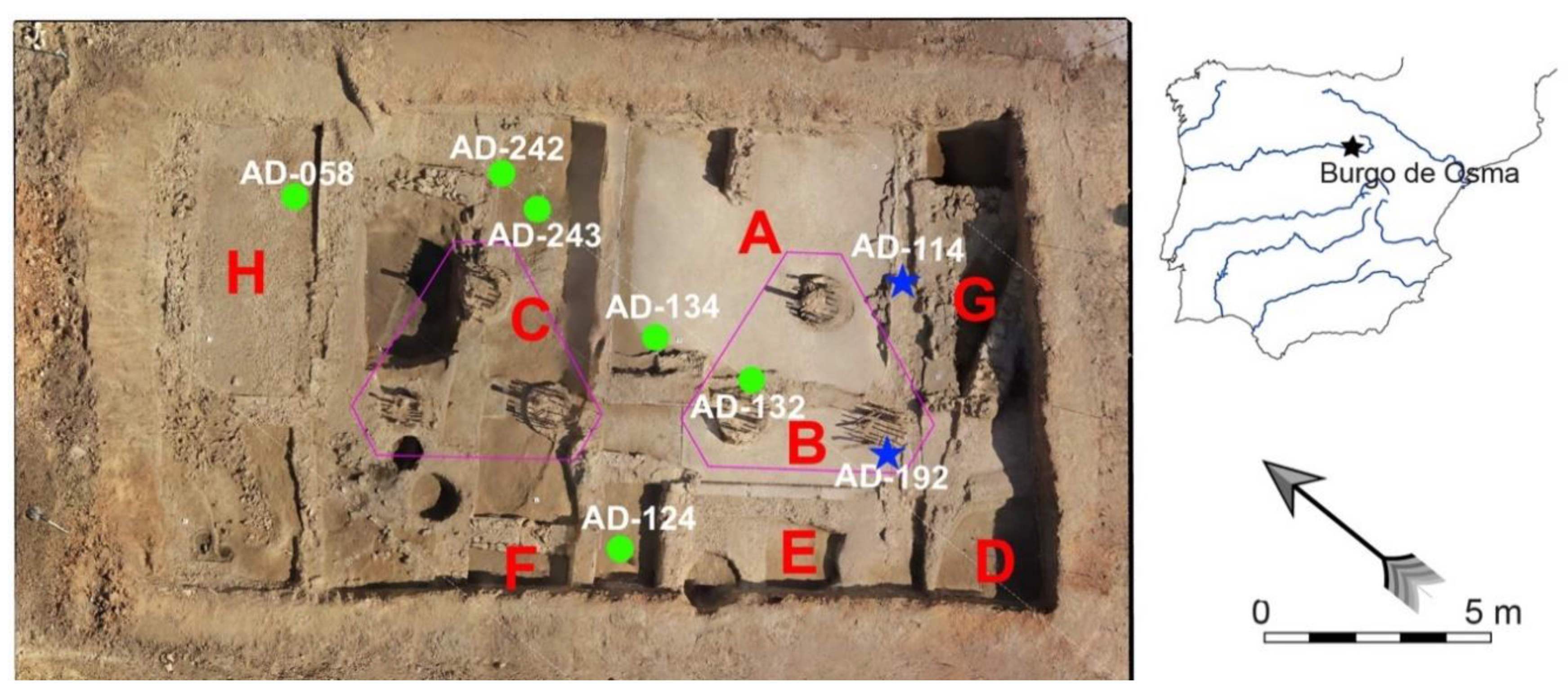

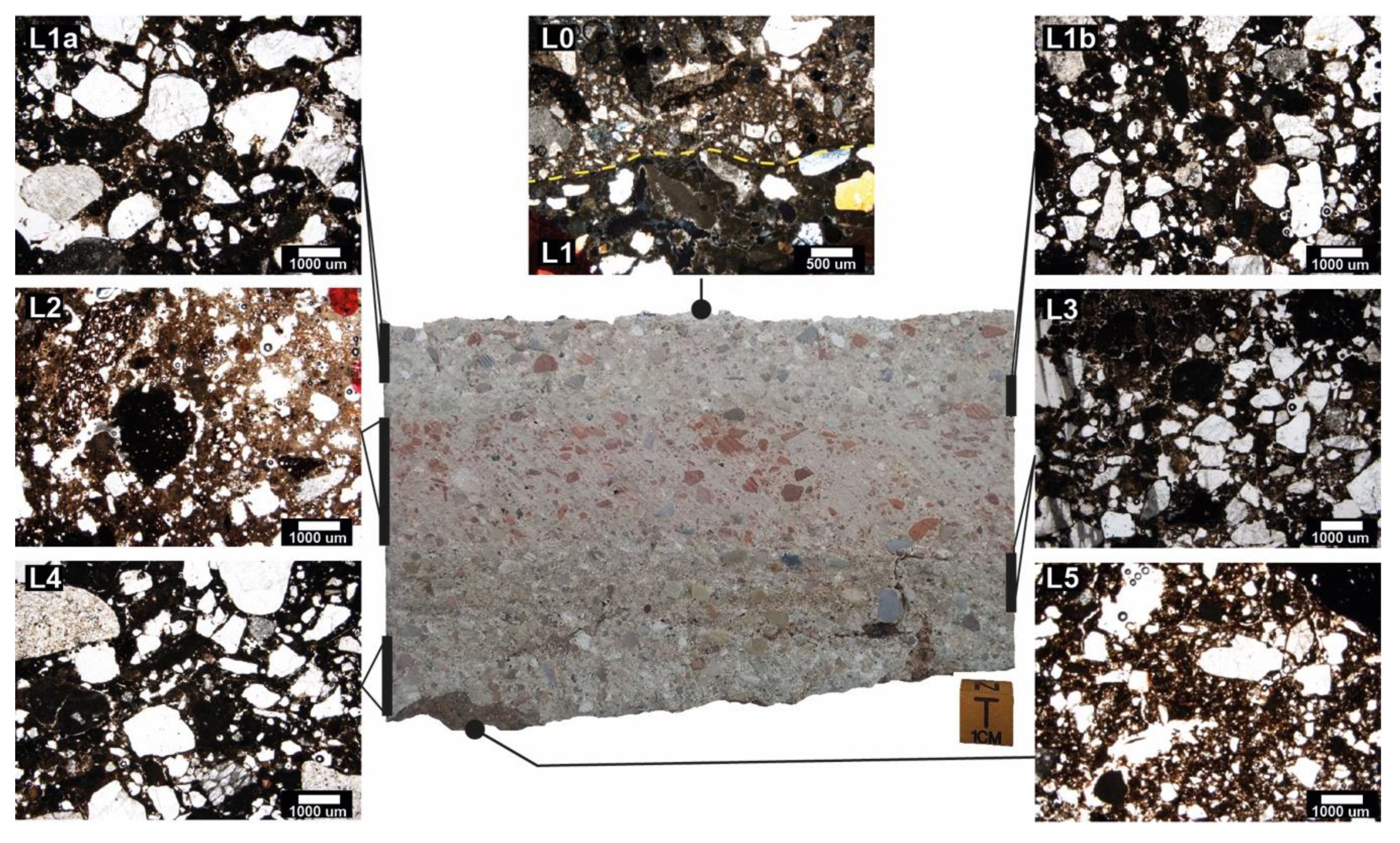

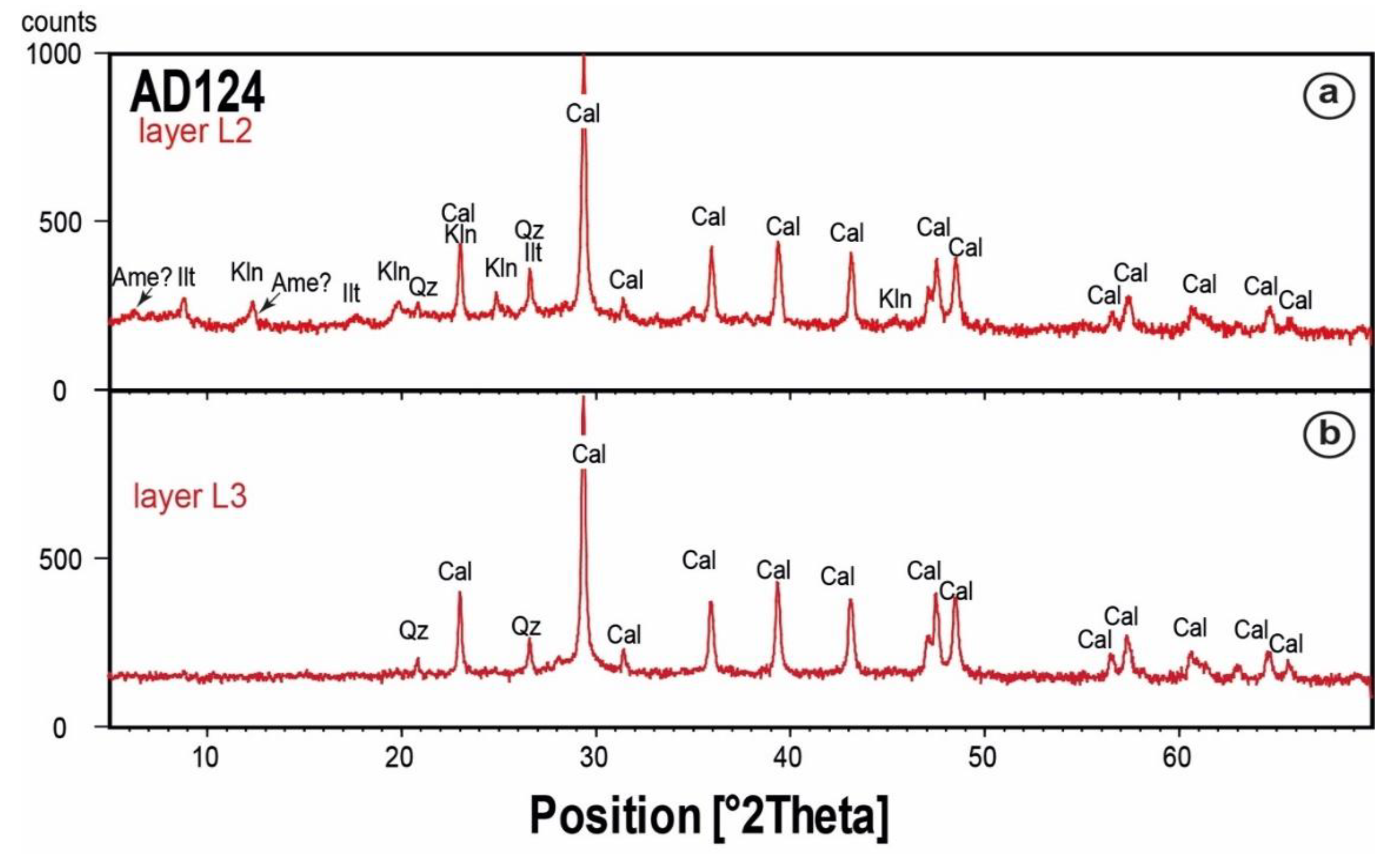

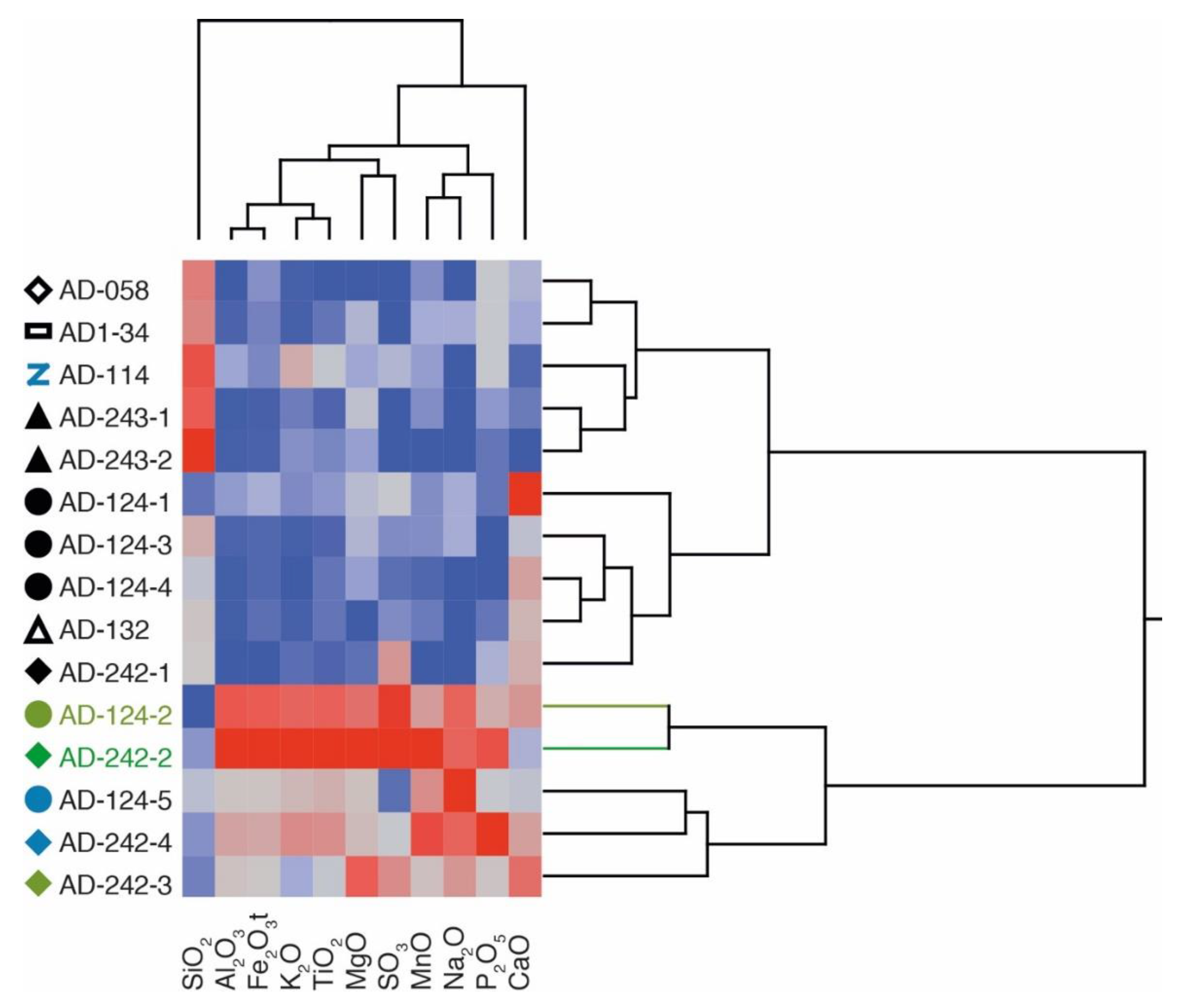
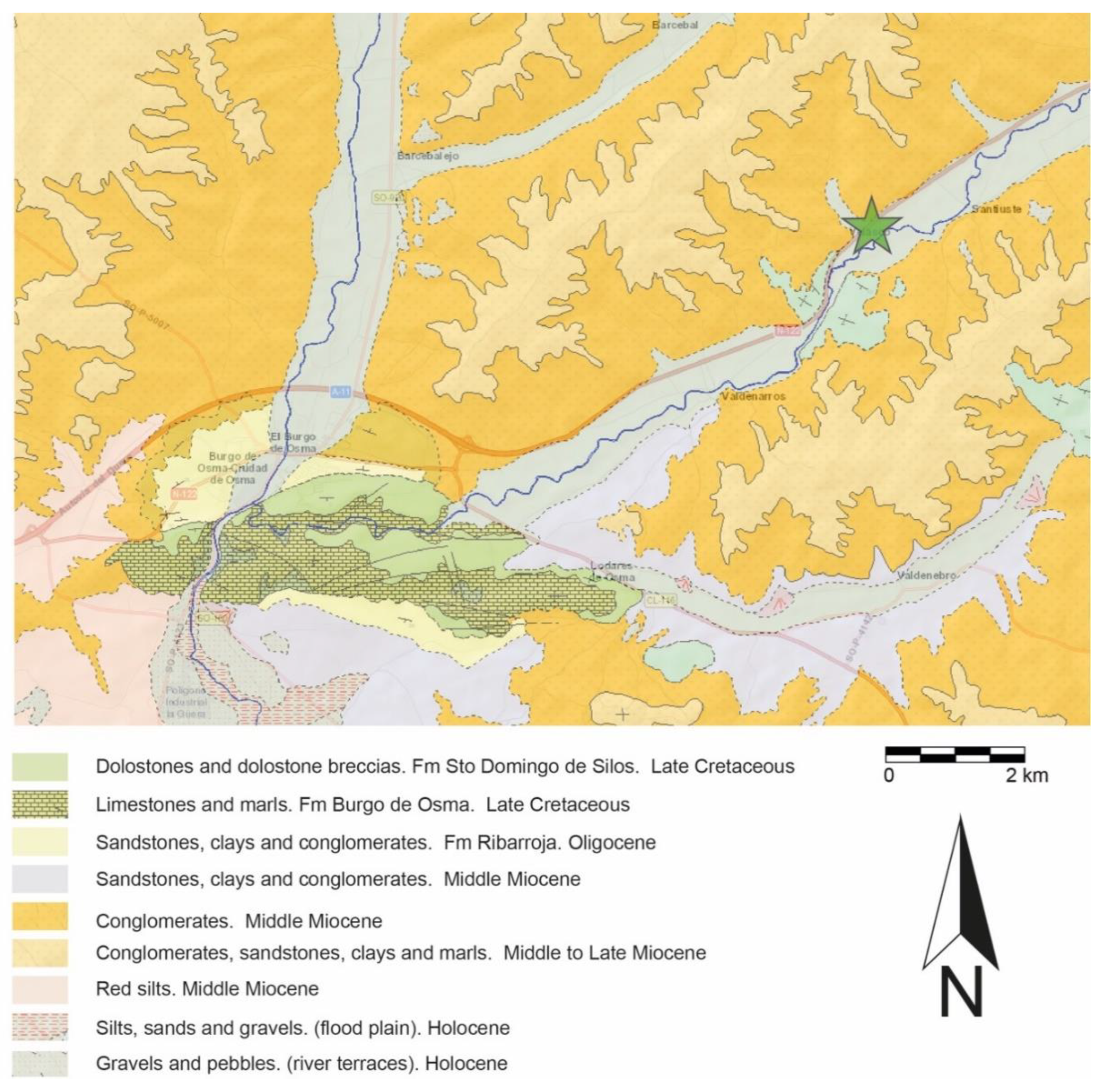
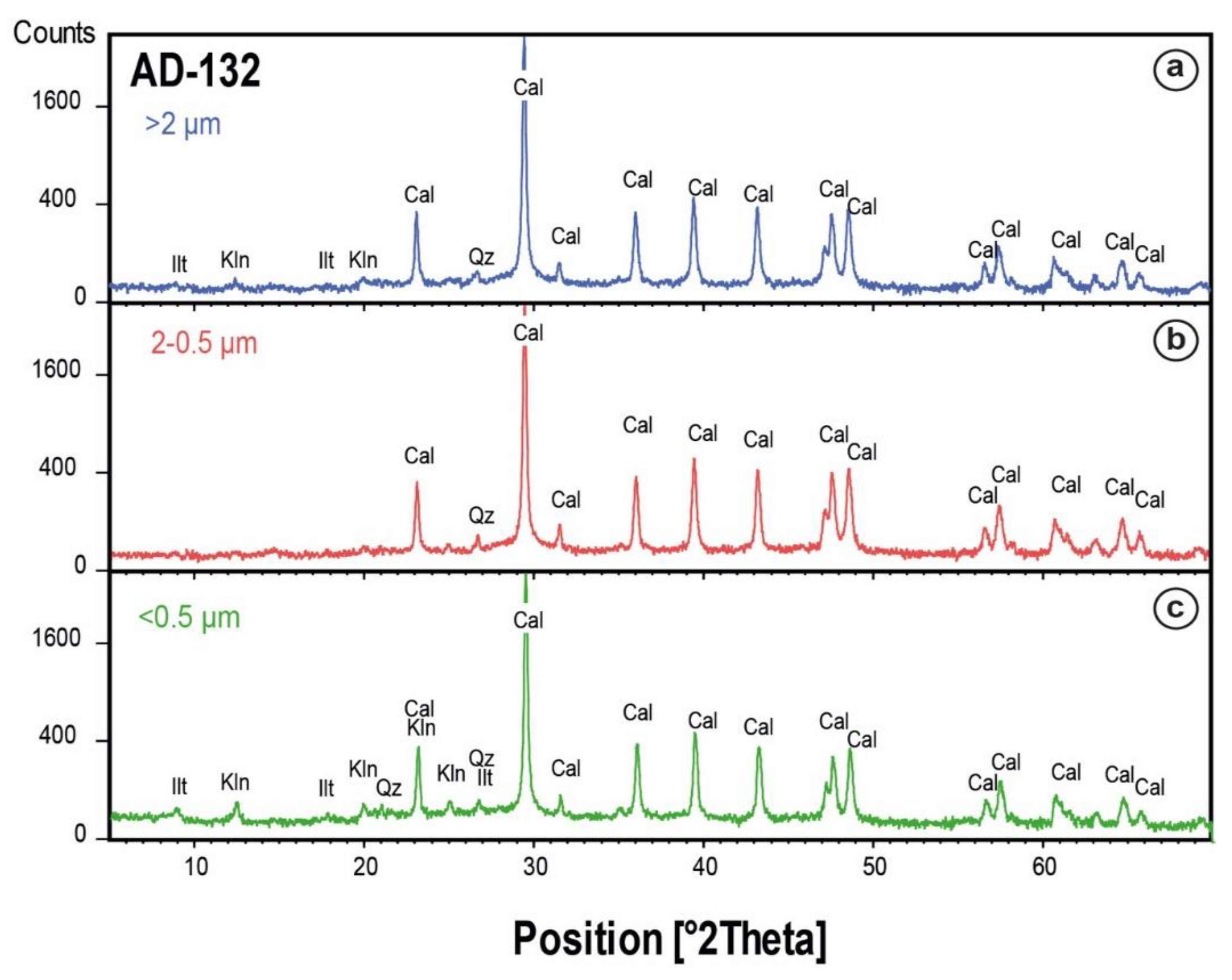
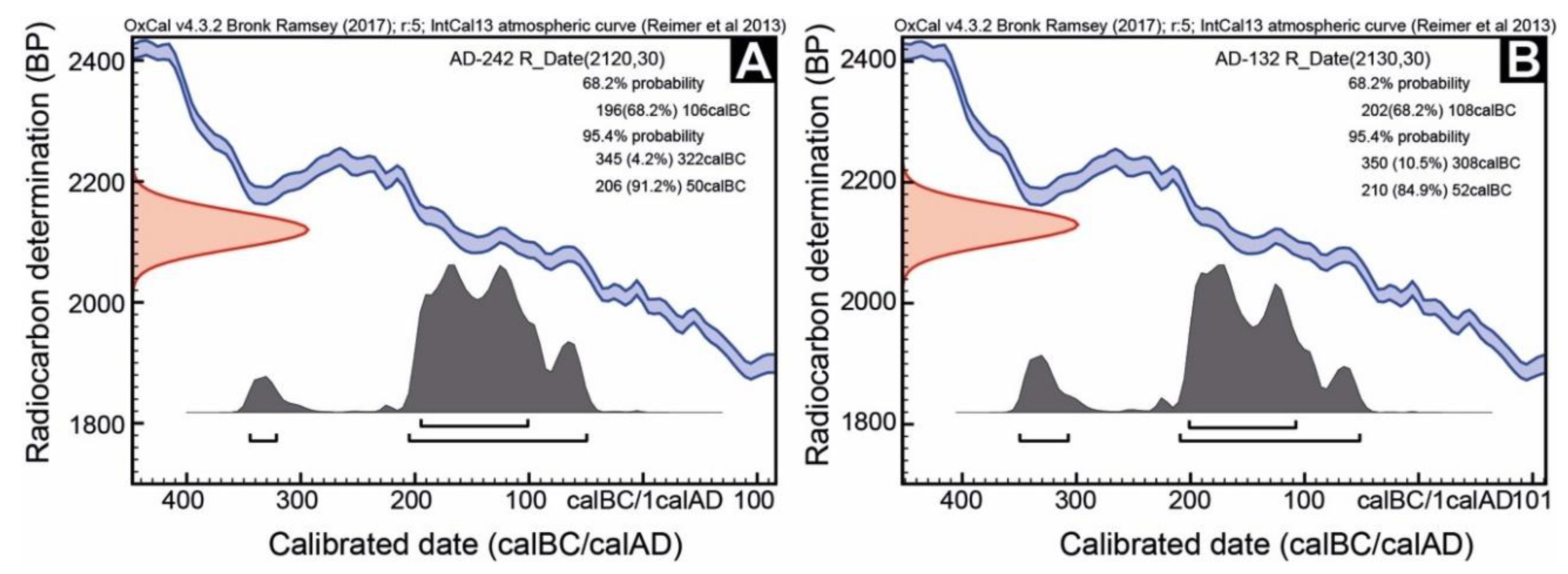
| Sample | Layers | Thickness (Cm) | Aggregates | ||||||
|---|---|---|---|---|---|---|---|---|---|
| Grain Size | Wentworth | Sorting | Nature | ||||||
| Mean | Max | Class | Minerals | Rock Fragments | |||||
| AD-132 | Wall | L0 | 0.1 | 0.25 | 1 | Fine sand | PS | Cal | Limestones |
| L1 | 1.5 | 0.6 | 3 | Coarse sand | VPS | Qz | Qzt >> Limestones > Lumps | ||
| L2 | 2 | 0.8–1 | 5 | Coarse sand | MS | Qz >> Fsp | Qzt >> Limestones > Lumps | ||
| AD-134 | L0 | 0.2 | 0.3 | 2 | Fine sand | VPS | Cal | Limestones | |
| L1 | 2 | 0.6 | 3 | Medium sand | MS | Qz >> Cal | Qzt> Sandstones >> Limestones | ||
| L2 | 2 | 0.6 | 4 | Small pebbles | MS | Qz >> Cal | Qzt> Sandstones >> Limestones | ||
| AD-242 | L0 | 0.1 | 0.3 | 1.5 | Fine sand | VPS | Cal | Limestones | |
| L1a | 2–4 | 1 | 2 | Fine sand | MS | Qz > Cal | Qzt >> Sandstone > limestone | ||
| L1b | 0–2 | 0.6 | 1.5 | Medium sand | PS | Qz | Qzt >> Sandstones >> Limestones | ||
| L2 | 2 | 1.2 | 5 | Coarse sand | PS | Qz | Ceramic >> Qzt | ||
| L3 | 2.5 | 0.2 | 3 | Fine-medium sand | VP | Qz > Cal | Qzt >> Ceramic powder | ||
| L4 | 2 | 0.11 | 2 | Very fine sand | MS | Qz | Siltstone > Limestone >> Ceramic | ||
| AD-243 | L0 | 0.2 | 0.3 | 1.5 | Medium sand | VPS | Cal > Qzt | Limestones | |
| L1 | 2 | 0.4 | 2 | Fine sand | WS | Qz >> Fsp | Qzt >> Lumps | ||
| L2 | 2.5 | 1 | 4 | Medium-coarse | PS | Qz >> Fsp | Qzt > Limestones > Lumps | ||
| AD-124 | L0 | 0.1 | 0.2 | 1 | Silt | PS | Cal | Limestones | |
| L1a | 2 | 0.3 | 2 | Medium sand | PS | Qz > Cal | Qzt >> ceramic | ||
| L1b | 2.5 | 0.6 | 2 | Coarse sand | MS | Qz | Qzt >> Limestone | ||
| L2 | 1.5 | 0.6 | 3 | Coarse sand | PS | Q > Cal >> Fsp | Ceramic >>> Qzt | ||
| L3 | 1.5 | 0.7 | 3 | Coarse sand | MS | Qz >> Fsp | Qzt >> Limestones >> Lumps | ||
| L4 | 1 | 1 | 5 | Very coarse | VPS | Qz > Cal | Qzt >> Limestones > Lumps | ||
| L5 | 1 | 0.4 | 5 | Medium sand | PS | Qz > Cal | Qzt > clays >> Limestones | ||
| AD-058 | L0 | 0.1 | 0.3 | 1 | Medium sand | PS | Cal > Qzt | Limestones | |
| L1 | 1.5 | 0.4 | 2.5 | Medium sand | PS | Qz >> Fsp | Qzt >> Lumps | ||
| L2 | 2.5 | 0.7 | 2.5 | Coarse sand | MS | Qz >> Fsp | Qzt >> Lumps | ||
| AD-114 | Floor | L1 | 1.5 | 0.24 | 0.6 | Medium sand | WS | Cal > Qz, Fsp | Clay |
| AD-192 | L0 | 0.1 | 0.2 | 2 | Silt | PS | Cal | Limestones | |
| L1 | 5.5 | 9 | 12 | Small pebble | MS | Qz | Limestones | ||
| L2 | 4–6 | 7 | 16 | Medium pebble | PS | Qz | Qzt | ||
| Sample | Calcite | Phyllosilicates | Quartz | Kln/Ilt | |
|---|---|---|---|---|---|
| AD-132 | Wall | 99 | 0 | 1 | − |
| AD-134 | 98 | 0 | 2 | − | |
| AD-242-L1 AD-242-L2 AD-242-L3 | 99 59 68 | 0 36 31 | 1 5 1 | − 13/23 28/3 | |
| AD-243 | 99 | 0 | 1 | − | |
| AD-124-L0 AD-124-L1 AD-124-L2 AD-124-L3 AD-124-L4 AD-124-L5 | 76 81 80 82 98 85 | 18 18 16 15 0 13 | 6 1 4 3 2 2 | 9/9 9/9 0/16 4/11 − 6/7 | |
| AD-058 | 77 | 23 | 1 | 17/6 | |
| AD-114 | Floor | 76 | 20 | 4 | 11/9 |
| AD-192-L1 AD-192-L2 | 99 99 | 0 0 | 1 1 | − − |
| Sample | SiO2 | Al2O3 | Fe2O3t | MnO | MgO | CaO | Na2O | K2O | TiO2 | P2O5 | SO3 | LOI |
|---|---|---|---|---|---|---|---|---|---|---|---|---|
| AD-132 | 52.97 | 0.87 | 0.31 | 0.01 | 0.13 | 22.12 | 0.00 | 0.32 | 0.07 | 0.04 | 0.04 | 22.90 |
| AD-134 | 58.54 | 0.97 | 0.38 | 0.02 | 0.24 | 19.17 | 0.01 | 0.32 | 0.07 | 0.07 | 0.02 | 19.11 |
| AD-242-1 | 52.58 | 0.82 | 0.20 | 0.01 | 0.16 | 22.47 | 0.00 | 0.36 | 0.06 | 0.06 | 0.13 | 22.40 |
| AD-242-2 | 45.06 | 8.79 | 2.75 | 0.03 | 0.56 | 19.55 | 0.04 | 1.58 | 0.40 | 0.16 | 0.21 | 20.09 |
| AD-242-3 | 43.35 | 3.09 | 0.86 | 0.01 | 0.49 | 24.81 | 0.03 | 0.50 | 0.13 | 0.08 | 0.14 | 25.09 |
| AD-242-4 | 44.64 | 4.63 | 1.38 | 0.03 | 0.32 | 23.13 | 0.04 | 1.09 | 0.26 | 0.18 | 0.07 | 22.66 |
| AD-243-1 | 61.31 | 0.88 | 0.24 | 0.01 | 0.26 | 17.49 | 0.00 | 0.39 | 0.06 | 0.05 | 0.02 | 18.92 |
| AD-243-2 | 64.29 | 0.92 | 0.25 | 0.01 | 0.21 | 16.21 | 0.00 | 0.43 | 0.08 | 0.04 | 0.02 | 17.26 |
| AD-124-1 | 42.37 | 1.65 | 0.58 | 0.01 | 0.25 | 26.77 | 0.01 | 0.42 | 0.09 | 0.04 | 0.07 | 26.59 |
| AD-124-2 | 39.58 | 7.39 | 2.28 | 0.02 | 0.46 | 23.44 | 0.04 | 1.30 | 0.33 | 0.10 | 0.20 | 24.06 |
| AD-124-3 | 55.17 | 0.98 | 0.28 | 0.01 | 0.24 | 20.35 | 0.01 | 0.32 | 0.06 | 0.03 | 0.04 | 21.68 |
| AD-124-4 | 50.41 | 0.87 | 0.28 | 0.01 | 0.21 | 23.06 | 0.00 | 0.30 | 0.07 | 0.03 | 0.03 | 23.61 |
| AD-124-5 | 49.94 | 3.02 | 0.94 | 0.02 | 0.31 | 20.42 | 0.05 | 0.79 | 0.20 | 0.07 | 0.03 | 22.78 |
| AD-058 | 59.07 | 0.81 | 0.43 | 0.01 | 0.13 | 19.62 | 0.00 | 0.32 | 0.05 | 0.07 | 0.02 | 19.25 |
| AD-114 | 62.00 | 1.81 | 0.40 | 0.01 | 0.22 | 16.87 | 0.00 | 0.87 | 0.13 | 0.07 | 0.06 | 15.93 |
| Lab Code | Sample | Conventional Age | δ13C | Calibrated Age Ranges (2σ) |
|---|---|---|---|---|
| Beta-511088 | AD-242 | 2120 +/− 30 BP | −14.3‰ | 206–50 BC (91.2%) |
| 345–322 BC (4.2%) | ||||
| Beta-511089 | AD-132 | 2130 +/− 30 BP | −14.4‰ | 210–52 BC (84.9%) |
| 350–308 BC (10.5%) |
© 2020 by the authors. Licensee MDPI, Basel, Switzerland. This article is an open access article distributed under the terms and conditions of the Creative Commons Attribution (CC BY) license (http://creativecommons.org/licenses/by/4.0/).
Share and Cite
Alonso-Olazabal, A.; Ortega, L.A.; Zuluaga, M.C.; Ponce-Antón, G.; Jiménez Echevarría, J.; Alonso Fernández, C. Compositional Characterization and Chronology of Roman Mortars from the Archaeological Site of Arroyo De La Dehesa De Velasco (Burgo De Osma- Ciudad De Osma, Soria, Spain). Minerals 2020, 10, 393. https://doi.org/10.3390/min10050393
Alonso-Olazabal A, Ortega LA, Zuluaga MC, Ponce-Antón G, Jiménez Echevarría J, Alonso Fernández C. Compositional Characterization and Chronology of Roman Mortars from the Archaeological Site of Arroyo De La Dehesa De Velasco (Burgo De Osma- Ciudad De Osma, Soria, Spain). Minerals. 2020; 10(5):393. https://doi.org/10.3390/min10050393
Chicago/Turabian StyleAlonso-Olazabal, Ainhoa, Luis Angel Ortega, Maria Cruz Zuluaga, Graciela Ponce-Antón, Javier Jiménez Echevarría, and Carmen Alonso Fernández. 2020. "Compositional Characterization and Chronology of Roman Mortars from the Archaeological Site of Arroyo De La Dehesa De Velasco (Burgo De Osma- Ciudad De Osma, Soria, Spain)" Minerals 10, no. 5: 393. https://doi.org/10.3390/min10050393
APA StyleAlonso-Olazabal, A., Ortega, L. A., Zuluaga, M. C., Ponce-Antón, G., Jiménez Echevarría, J., & Alonso Fernández, C. (2020). Compositional Characterization and Chronology of Roman Mortars from the Archaeological Site of Arroyo De La Dehesa De Velasco (Burgo De Osma- Ciudad De Osma, Soria, Spain). Minerals, 10(5), 393. https://doi.org/10.3390/min10050393





